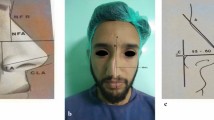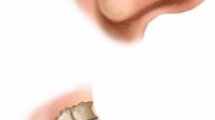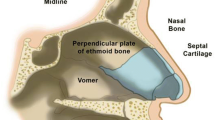Abstract
Cephalic resection of the lateral crura of the alar cartilages, lateral osteotomies, and removal of the nasal hump during rhinoplasty may cause collapse of the internal nasal valve angle. This study was performed to compare preventive effects of two techniques (spreader grafts and flaring sutures) on rhinoplasty by rhinomanometry. Two hundred and forty-eight patients participated in this semi-experimental study. The patients were assigned into two groups. 28 of them were not available for follow-up. All patients had a straight nose in the midline and no severe septal deviations. 87 of 220 patients underwent the spreader grafts technique and the flaring sutures technique was performed in 133 patients. The nasal airway resistance was calculated by active anterior rhinomanometry on admission to hospital and again between 3 and 6 months following surgery. The mean of follow-up was 20.9 ± 2.9 weeks. After rhinoplasty, nasal airway resistance decreased in 46 patients (52.9 percent) of spreader grafts group and in 84 patients (63.2 percent) of flaring sutures group. The median nasal airway resistance difference (before–after surgery) of spreader grafts and flaring sutures groups was 0.027 Pa/ml/s (range −110 to 130) and 0.017 Pa/ml/s (range −0.690 to 0.790), respectively. The difference of nasal airway resistance between before and after rhinoplasty in two groups was insignificance (Mann–Whitney U test, P = 0.5). The spreader grafts and flaring sutures move the dorsal border of the upper lateral cartilage in a lateral direction and had similar preventive effect on nasal airway resistance after rhinoplasty.
Similar content being viewed by others
References
Schlosser RJ, Park SS (1999) Surgery for the dysfunctional nasal valve. cadaveric analysis and clinical outcomes. Arch Facial Plast Surg 1(2):105–110
Toriumi DM (1995) Management of the middle nasal vault in rhinoplasty. Operat Tech Plast Reconstr Surg 2:16–30
Teller DC (1997) Anatomy of a rhinoplasty: emphasis on the middle third of the nose. Facial Plast Surg 13:241–252
Omranifard M, Abdali H, Rasti Ardakani M, Ahmadnia AY (2013) Comparison of the effects of spreader graft and overlapping lateralcrural technique on rhinoplasty by rhinomanometry. World J Plast Surg 2(2):99–103
Sheen JH (1984) Spreader graft: a method of reconstructing the roof of the middle nasal vault following rhinoplasty. Plast Reconstr Surg 73:230–239
Boccieri A, Macro C, Pascali M (2005) The use of spreader grafts in primary rhinoplasty. Ann Plast Surg 55:127–131
Constantian MB (2000) Four common anatomic variants that predispose to unfavorable rhinoplasty results: a study based on 150 consecutive secondary rhinoplasties. Plast Reconstr Surg 105:316
Zijlker TD, Quaedvlieg PC (1994) Lateral augmentation of the middle third of the nose with autologous cartilage in nasal valve insufficiency. Rhinology 32:34–41
Park SS (1998) The flaring suture to augment the repair of the dysfunctional nasal valve. Plast Reconstr Surg 101:1120–1122
Bermüller C, Kirsche H, Rettinger G, Riechelmann H (2008) Diagnostic accuracy of peak nasal inspiratory flow and rhinomanometry in functional rhinosurgery. Laryngoscope 118(4):605–610
Schumacher MJ (2002) Nasal congestion and airway obstruction: the validity of available objective and subjective measures. Curr Allergy Asthma Rep 2(3):245–251
Chandra RK, Patadia MO, Raviv J (2009) Diagnosis of nasal airway obstruction. Otolaryngol Clin N Am 42(2):207–225
Clement PAR, Gordts F (2005) Consensus report on acoustic rhinometry and rhinomanometry. Rhinology 43:169–179
Crouse U, Laine-Alava MT (1999) Effects of age, body mass index, and gender on nasal airflow rate and pressures. Laryngoscope 109(9):1503–1508
Jessen M, Jacobsson S, Malm L (1988) On rhinomanometry in rhinoplasty. Plast Reconstr Surg 81(4):506–511
Gordon AS, McCaffrey TV, Kern EB, Pallanch JF (1989) Rhinomanometry for preoperative and postoperative assessment of nasal obstruction. Otolaryngol Head Neck Surg 101:20–26
Gassner HG, Friedman O, Sherris DA, Kern EB (2006) An alternative method of middle vault reconstruction. Arch Facial Plast Surg 8(6):432–435
Bloching MB (2007) Disorders of the nasal valve area. GMS Curr Top Otorhinolaryngol Head Neck Surg 6:Doc07 (Epub 2008 Mar 14)
Acknowledgments
I thank the patients for their participation in this study.
Conflict of interest
None.
Author information
Authors and Affiliations
Corresponding author
Rights and permissions
About this article
Cite this article
Jalali, M.M. Comparison of effects of spreader grafts and flaring sutures on nasal airway resistance in rhinoplasty. Eur Arch Otorhinolaryngol 272, 2299–2303 (2015). https://doi.org/10.1007/s00405-014-3327-5
Received:
Accepted:
Published:
Issue Date:
DOI: https://doi.org/10.1007/s00405-014-3327-5




